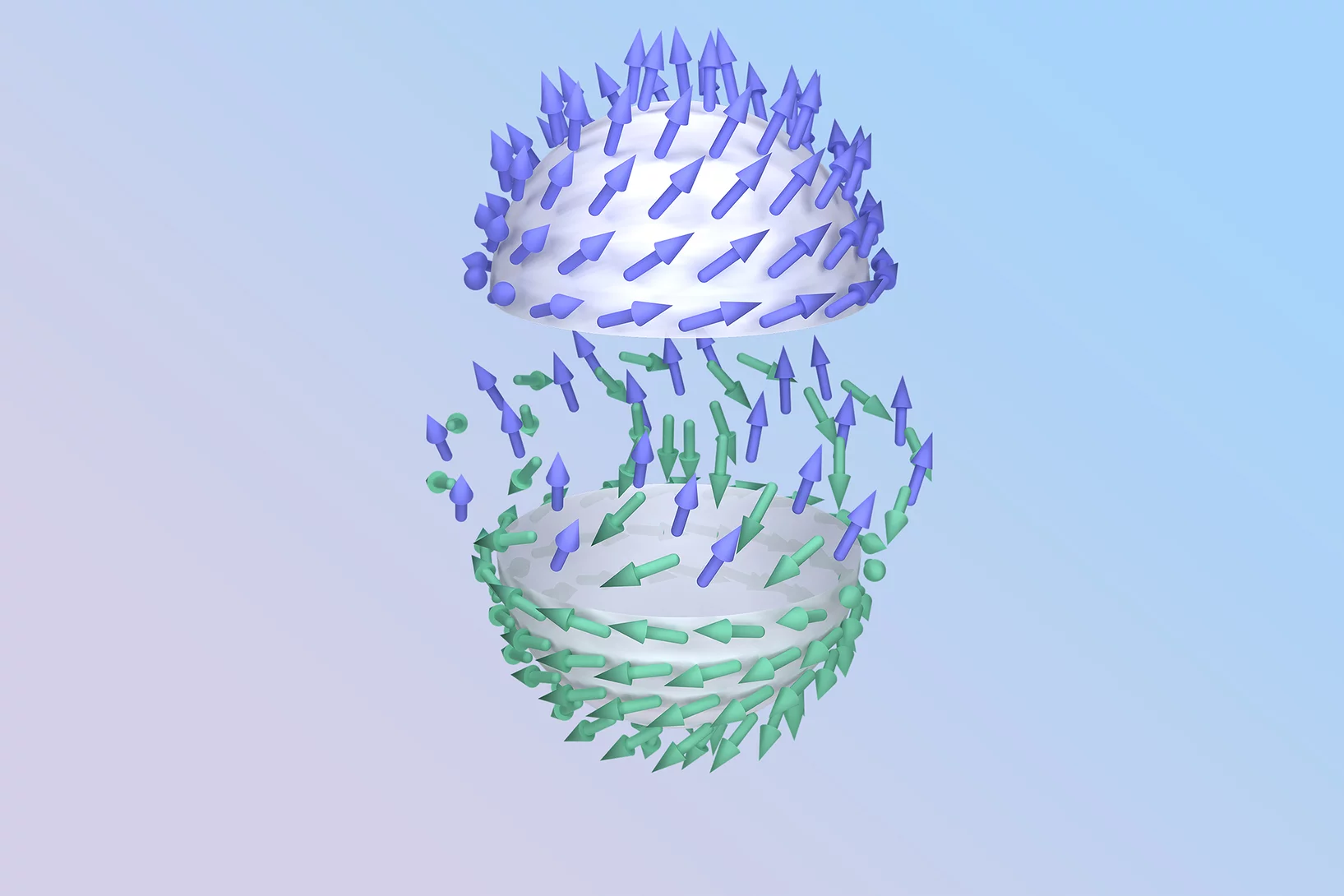At PSI, several projects are dedicated to important research questions concerning the Sars-CoV-2 coronavirus and the resulting diseases. We provide information on activities and projects, for example on investigations of lung tissue, on the production of proteins and antibodies or on ideas for new research on Covid-19.
Useful links
Imaging strain with high resolution
Imaging strain in crystalline materials with high resolution can be a challenging task. Researchers demonstrate an original use of X-ray ptychography for this purpose: ptychographic topography.
Vital role of magnetocrystalline anisotropy in cubic chiral skyrmion hosts
Magnetic anisotropy is anticipated to govern the formation of exotic spin textures reported recently in cubic chiral magnets, like low-temperature tilted conical and skyrmion lattice (SkL) states and metastable SkLs with various lattice geometry. Motivated by these findings, we quantified the cubic anisotropy in a series of CoZnMn-type cubic chiral magnets. We found that the strength of anisotropy is highly enhanced towards low temperatures. Moreover, not only the magnitude but also the character of cubic anisotropy drastically varies upon changing the Co/Mn ratio.
The innovation campus is progressing
The innovation campus of Park Innovaare is growing in leaps and bounds. The modern buildings, under construction in the immediate vicinity of PSI, are ideally suited to the R&D needs of industry with office-, laboratory- and clean room space.
Since the ground-breaking ceremony in November 2019, construction work on the 38,000 m2 buildings, led by ERNE AG, has been on schedule and completion is expected at the end of 2023. Then the companies and spin-offs already located in the park, as well as several PSI departments, will move into the new buildings along with other companies wanting to benefit from Park Innovaare's innovation ecosystem.
For further information: https://www.parkinnovaare.ch/switzerland-innovation-hightech-campus-research-park
Tracking down unreported Coronavirus cases
The University Hospital of Zurich uses proteins made at PSI for Europe’s first large-scale serology study on coronavirus prevalence in Switzerland.
Raman spectroscopic evidence for multiferroicity in rare earth nickelate single crystals
The rare earth nickelates RNiO3 are metallic at high temperatures and insulating and magnetically ordered at low temperatures. The low temperature phase has been predicted to be type II multiferroic, i.e., ferroelectric and magnetic order are coupled and occur simultaneously. Confirmation of those ideas has been inhibited by the absence of experimental data on single crystals. Here we report on Raman spectroscopic data of RNiO3 single crystals (R = Y, Er, Ho, Dy, Sm, Nd) for temperatures between 10 and 1000 K. Entering the magnetically ordered phase we observe the appearance of a large number of additional vibrational modes, implying a breaking of inversion symmetry expected for multiferroic order.
How ethane-consuming archaea pick up their favorite dish
Scientists decode the structure of the enzyme responsible for the ethane fixation by – beside others – using the SLS.
Updated information flyer: user operation during COVID-19 period
PSI has updated the information and guidelines for our users that apply during the COVID-19 pandemic period according to the obligation for our users to present a certificate of a negative PCR or rapid antigen test or the certificate of a full vaccination/recovery.
New research division at PSI points to the future of data
PSI is establishing a new research division: Scientific Computing, Theory, and Data.
First Mu3e Integration Run
During an extensive campaign at PSI, the Mu3e collaboration for the first time operated parts of the detector inside the experiment magnet and with muon beam stopping on a target in the center of the experiment.
Bedürfnisorientierte Spielangebote in der Kita Kiwi
Was heisst bedürfnisorientierte Spielangebote anbieten und was löst es aus?
Gold wert - "Was wir machen, machen wir richtig"
Erfahrungen aus der Teilprüfungsvorbereitungen und was haben wir daraus gelernt?
Preventing the break-in of the toxoplasmosis parasite
Scientists have identified the structure and functions of RON13, an enzyme of the toxoplasmosis parasite that is essential for the infectious mechanism in humans.
Unsplit superconducting and time reversal symmetry breaking transitions in Sr2RuO4 under hydrostatic pressure and disorder
There is considerable evidence that the superconducting state of Sr2RuO4 breaks time reversal symmetry. In the experiments showing time reversal symmetry breaking, its onset temperature, TTRSB, is generally found to match the critical temperature, Tc, within resolution. In combination with evidence for even parity, this result has led to consideration of a dxz ± idyz order parameter.
Circular Economy Entrepreneur Conference (CE2) 2021
Circular cities, food and agriculture as well as infrastructure and logistics: this is the focus of the third edition of CE2 on 22 September 2021 at the Kursaal Bern. The conference is the compass for companies that want to anchor sustainable business and the circular economy in their DNA. Renewable energies and recycling are important innovation topics at PSI - this is why we support CE2 as a partner.
Meet other forward-thinkers, designers, and specialists, exchange ideas and get inspired by around 25 experts in keynotes and deep dive sessions. These include Simonetta Sommaruga (Federal Councillor), Thomas Vellacott (CEO, WWF Switzerland), Cllr. Anna Richardson (City Convener, Sustainability and Carbon Reduction, Glasgow City Council), Dr Ian Roberts (CTO, Bühler Group) and Patrick Camele (CEO, SV Group).
Further information and registration at www.ce2.ch/en/
PSI: advancing in the fight against Covid-19
Crystal structure analysis, computer models, cell cultures – to pursue research on Sars-CoV-2, PSI is exploring many avenues. An overview.
Quantum billiards with correlated electrons
Our collaborators at the Jozef Stefan Institute – the leading author, Jan Ravnik, is now a PSI Fellow at LMN – report a study of the electron ordering in equilateral triangle structures via photoexcitation of the prototypical dichalcogenide 1T-TaS2.
Change at the top of the Board of Directors of Park Innovaare
For the last three years, Dr Remo Lütolf, the retiring Chairman of the Board of innovAARE AG in Villigen has successfully guided the development of Park Innovaare. With his background as former country manager of ABB Switzerland, Remo Lütolf was able to incorporate his broad know-how and experience from industry into his mandate for the Park. His successor, Dr Christian Brönnimann, is the founder and CEO of Dectris AG, a company based in Baden-Daettwil. Dectris is the world's number one in the manufacture of X-ray detectors, and is a successful spin-off company of the Paul Scherrer Institute.
LRC and BluAct explore innovative filter material
Fission products from the PSI-SINQ gas-jet facility, as operated by LRC, were used to reveal the separation of relevant radionuclides from radioactively contaminated water. The tests were conducted using a novel innovative filter material made of a blend of milk whey and active charcoal on cellulose. This material has been developed by the ETHZ spin-off BluAct Technologies GmbH.
The importance of this project was recently highlithed in ETSON/news
PSI e-Learning Produktionen erneut ausgezeichnet
Zum dritten Mal in Folge wurden zwei unserer hauseigenen e-Learning Produktionen mit einem Siegel des renommierten Comenius EduMedia Awards für exemplarische Bildungsmedien ausgezeichnet.
Protonentherapie am PSI: Vortrag und Live-Video-Rundgang
In der Reihe "Forschung online erleben" veranstaltet das PSI am Mittwoch, 23. Juni 2021 von 19 bis 21 Uhr einen virtuellen Vortrag & Rundgang durch die Krebsbehandlungsanlagen am PSI. Erfahren Sie mehr darüber, welche Krebsarten am Zentrum für Protonentherapie des PSI mit Protonen behandelt werden, welche Patienten für eine solche Therapie infrage kommen und wie eine Behandlung abläuft.
Wählen Sie sich über diesen Link direkt in den Live-Video-Rundgang ein:
Mittwoch, 23. Juni 2021 – 19 bis 21 Uhr
https://psich.zoom.us/j/61021531635 , Meeting-ID: 61021531635
Weiterführende Informationen finden Sie unter folgendem Link:
https://www.psi.ch/de/psiforum/news/forschung-online-erleben-die-protonentherapie-am-psi
Stoneflies: Youth influences adulthood
Evolutionary biologists at the University of Bonn scan 219 species in different particle accelerators, beside others the Swiss Light Source SLS.
How immune cells are activated
A research consortium has deciphered the mechanism of CCR5 receptor activation, providing insights for the development of CCR5 drug antagonists for AIDS, cancer, and inflammatory diseases.
‘Ice Memory Mission’ accomplished
During its expedition to the Monte Rosa massif, the international Ice Memory team extracted two ice cores over 80 meters long from Colle Gnifetti, the oldest ice in the Alps.
Magnetic nanoworld
At PSI, researchers come across exotic phenomena such as frustrated magnets and nano-vortices, which may one day enable better data storage.
RENiO3 Single Crystals (RE = Nd, Sm, Gd, Dy, Y, Ho, Er, Lu) Grown from Molten Salts under 2000 bar of Oxygen Gas Pressure
The electronic properties of transition-metal oxides with highly correlated electrons are of central importance in modern condensed-matter physics and chemistry, both for their fundamental scientific interest and for their potential for advanced electronic applications. However, the design of materials with tailored properties has been restricted by the limited understanding of their structure–property relationships, which are particularly complex in the proximity of the regime where localized electrons become gradually mobile. RENiO3 perovskites, characterized by the presence of spontaneous metal to insulator transitions, are some of the most widely used model materials for the investigation of this region in theoretical studies. However, crucial experimental information needed to validate theoretical predictions is still lacking due to their challenging high-pressure synthesis, which has prevented to date the growth of sizable bulk single crystals with RE ≠ La, Pr, and Nd. Here we report the first successful growth of single crystals with RE = Nd, Sm, Gd, Dy, Y, Ho, Er, and Lu in sizes up to ∼75 μm, grown from molten salts in a temperature gradient under 2000 bar of oxygen gas pressure. The crystals display regular prismatic shapes with flat facets, and their crystal structures and metal–insulator and antiferromagnetic order transition temperatures are in excellent agreement with previously reported values obtained from polycrystalline samples. The availability of such crystals opens access to measurements that have hitherto been impossible to conduct. This should contribute to a better understanding of the fascinating properties of materials with highly correlated electrons and guide future efforts to engineer transition-metal oxides with tailored functional properties.
Cross-Talk–Suppressing Electrolyte Additive for Li-ion Batteries
Control of interfacial reactivity at high-voltage is a key to high-energy-density Li-ion batteries. 2-aminoethyldiphenyl borate was investigated as an electrolyte additive to stabilize surface and bulk of both NCM851005 and graphite in the cell with upper cut-off voltage of 4.4 V vs Li+/Li. AEDB almost completely eliminated the “cross-talk” in the cell, by significantly reducing metal leaching from the cathode, preventing their deposition at the anode, and further electrolyte decomposition.
Mein kulinarischer Alltag
Herausforderung: Gemüselasagne
RENiO3 Single Crystals (RE = Nd, Sm, Gd, Dy, Y, Ho, Er, Lu) Grown from Molten Salts under 2000 bar of Oxygen Gas Pressure
Schematic representation of the method used to grow RENiO3 nickelate single crystals covering the full 4f series and Y. This novel procedure, based on the use of moderate oxygen gas pressures (2000 bar), solvothermal growth in a temperature gradient, and highly reactive eutectic salt mixtures as fluxes, yields prismatic-shaped crystals with flat facets and sizes up to ∼75 μm.
Two scenarios for superconductivity in CeRh2As2
CeRh2As2, a nonsymmorphic heavy fermion material, was recently reported to host a remarkable temperature versus z-axis magnetic-field phase diagram with two superconducting phases. In this material, the two inequivalent Ce sites per unit cell, related by inversion symmetry, introduce a sublattice structure corresponding to an extra internal degree of freedom. In this work, we propose a classification of the possible superconducting states in CeRh2As2 from the two Ce-sites' perspective.
Giant phonon anomalies in the proximate Kitaev quantum spin liquid α-RuCl3
The Kitaev quantum spin liquid epitomizes an entangled topological state, for which twoflavors of fractionalized low-energy excitations are predicted: the itinerant Majorana fermion and the Z2 gauge flux. It was proposed recently that fingerprints of fractional excitations are encoded in the phonon spectra of Kitaev quantum spin liquids through a novel fractional- excitation-phonon coupling. Here, we detect anomalous phonon effects in α-RuCl3 using inelastic X-ray scattering with meV resolution.



























